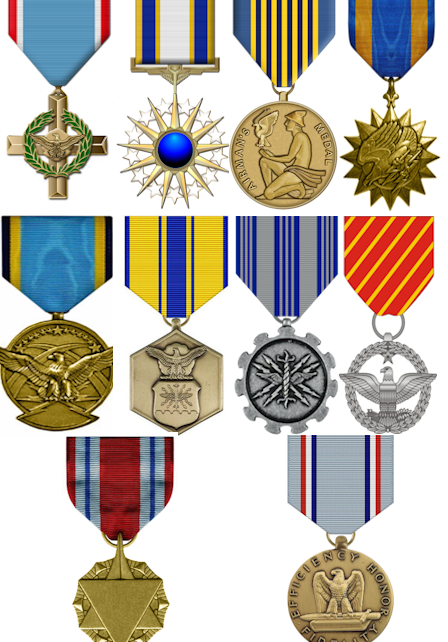Air Force medals represent some of the highest honors and achievements in military service.
These military decorations provide a way to demonstrate the accomplishments of individual airmen.
As such, they are proudly displayed on the formal uniform in a certain order of precedence.
Learn more about Air Force medals ranked in order of importance / prestige.
Related Article – 10 Marine Corps Medals Explained
Table of Contents
Air Force Medals Ranked in Order
The United States Air Force (USAF) has a proud tradition just like the other branches of the Armed Forces.
Accordingly, the military branch frequently awards medals and ribbons to eligible Airmen.
These include prestigious military awards such as the Air Force Cross and Aerial Achievement Medal.
It’s important to recognize the appearance and qualifications of each Air Force medal in order to distinguish them.
Furthermore, understanding the order of precedence ensures proper placement on the formal military uniform.
Thus, Air Force medals are ranked in the following order of importance / prestige:
- Air Force Cross
- Air Force Distinguished Service Medal
- Airman’s Medal
- USAF Air Medal
- Ariel Achievement Medal
- Air & Space Commendation Medal
- Air & Space Achievement Medal
- Combat Action Medal
- Combat Readiness Medal
- Air Force Good Conduct Medal
The U.S. Air Force first began presenting awards and decorations in 1947.
Previously, Airmen were mostly eligible for military awards issued to members of the U.S. Army.
However, following the Cuban Missile Crisis, the service branch started presenting its own distinct awards.
Today, the USAF has started to include the recently created Space Force in many of its military awards and decorations.
Learn more about the Air Force medals ranked in order of precedence, below:
#1. Air Force Cross
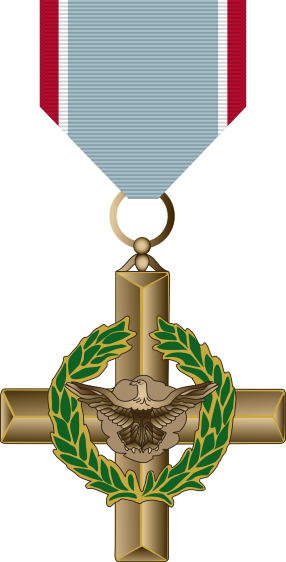
The Air Force Cross (AFC) is the second highest military decoration in the service branch, only behind the Medal of Honor.
It’s awarded to airmen and guardians who distinguish themselves with extraordinary heroism in combat with an armed enemy force.
Thus, anyone serving in the United States Air Force or Space Force is eligible for the distinction.
The Air Force Cross is the equivalent of the U.S. Navy Service Cross and Coast Guard.
Additionally, the United States Army presents a similar award in the Distinguished Service Cross.
Before 1960, members of the Air Force received the same award as Army personnel (the Distinguished Service Cross).
Nonetheless, the proposal to create a separate award for the USAF dates back to the late 1940s, shortly after the creation of the military branch.
The appearance of the medal is very distinct and was created by a former employee of the Air Force.
It consists of a bronze cross with an American bald eagle, wings displayed against a cloud formation, in the center of the medal.
The design is supposed to replicate the crest of the Department of Air Force Seal.
Thus, it’s encircled by a laurel wreath finished with green enamel, to complete one of the finest decorations in military service.
Meanwhile, the reverse side of the medal is generally engraved with the recipient’s name and military rank.
Today, the Air Force Cross remains one of the hardest achievements to earn in the military considering just over 200 service members have earned it lifetime.
Thus, the ceremony is usually a big deal and takes place at the Pentagon (where the medal and ribbon are presented by the Secretary of the Air Force).
#2. Air Force Distinguished Service Medal
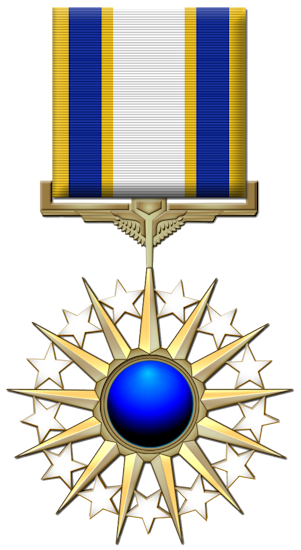
The Distinguished Service Medal (DSM) is another top honor granted to service members in the Air Force.
It’s presented to airmen and guardians that display distinguished and exceptionally meritorious service to the United States.
The primary stipulation is that this “distinguished and exceptionally meritorious service” must take place while serving in a duty or position of great responsibility.
Thus, a little more discretion is used for the Distinguished Service Medal unlike the Air Force Cross, which must occur in combat situations.
Notwithstanding, the military award is generally only presented to Air Force officers and those that hold the rank of major general, or higher.
Still, the qualifications are often reduced upon retirement, where ranking members including brigadier general, are often eligible.
The Air Force Distinguished Service Medal was established in 1960 and first awarded to airmen in 1965.
It ranks as the equivalent of the U.S. Army Distinguished Service Medal, along with the versions of the award presented in the Coast Guard and Navy.
Appearance
The Air Force Distinguished Service Medal features a sunburst design that ranks among the most decorative military awards.
The 13 gold rays are separated by 13 white enameled stars, along with a semiprecious blue stone displayed in the center of the medal.
Meanwhile, the reverse side of the medal is left blank where award winners often engrave their name.
The medal is suspended by a service ribbon, just like all the other military awards on the list.
Furthermore, eligible personnel is permitted to display oak leaf clusters (for additional awards) along with the combat “C” device.
The authorization of the “C” device on the uniform is largely based on the specific circumstances under which the service or achievement was performed.
Therefore, the service member must have been personally exposed to hostile action or under significant risk of hostile action.
Related Article – 15 US Navy Ribbons Explained
#3. Airman’s Medal
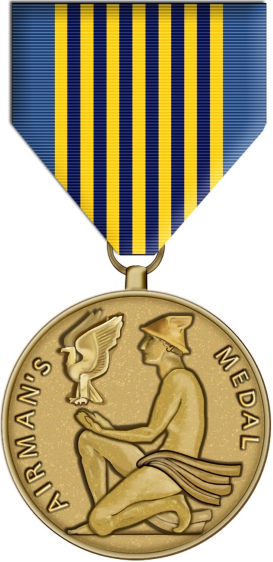
The Airman’s Medal is another important military decoration presented to members of the Air Force.
It’s dedicated to those who, while serving in any capacity within the USAF, have distinguished themselves through a heroic act.
Often, these “heroic acts” are usually at the voluntary risk of the airmen’s life yet not while engaged in actual combat with a hostile enemy.
In general, the heroic act must have involved a personal hazard or danger.
The Airman’s Medal was established in 1956 as a replacement for the U.S. Army Soldier’s Medal.
It’s also considered the equivalent of the Navy and Marine Corps Medal and the Coast Guard Medal.
However, the Airman’s Medal is unusual in that its shape does not follow the typical octagonal shape of the other equivalents.
Rather, the medal features the Greek god Hermes, son of Zeus, resting on one knee.
The hands are open indicating Hermes has just released an American bald eagle, assisting the bird into flight.
Then, on the reverse side of the medal, the raised outer edge features the inscription: “For Valor” above a space reserved for the recipient’s name.
Moreover, additional awards of the Airman’s Medal are denoted by oak leaf clusters, like the other medals on the list.
Today, the military award is also open to members of the United States Space Force, along with members of a friendly nation serving in any capacity under the USAF.
#4. Air Medal
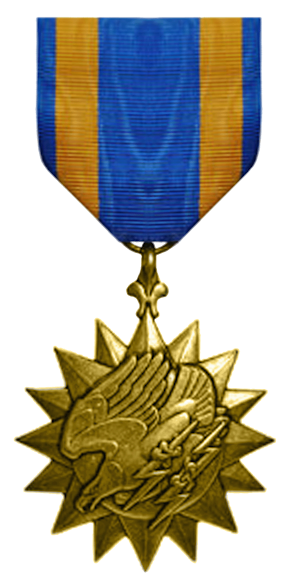
The Air Medal (AM) ranks as one of the most important Air Force decorations.
It was created to recognize acts of heroism or meritorious achievement while participating in aerial flight.
President FDR established the award in 1942 and has been presented retroactively since 1939.
During World War II, aerial forces were combined with the U.S. Army since the Air Force had not officially been established as its own service branch.
Notwithstanding, discrepancies between the Air Medal and Distinguished Flying Cross caused the USAF to create its own distinct honor.
Thus, the Air Medal is now designed to recognize either single acts of merit or gallantry in combat situations.
Generally, eligible recipients are current crew members or non-crew members that require them to participate in aerial flights on a frequent basis.
However, the Air Medal is also awarded to individuals whose combat duties demand regular and frequent flying other than “passenger status.”
Additionally, the military award is also provided to those that perform a noteworthy act while functioning as a crew member (but lacking flying status).
The United States Air Force, unlike the Army, does not award the Air Medal for peacetime sustained operational activities and flights.
Rather, non-combat meritorious service is recognized thanks tot he Aerial Achievement Medal (see, below).
Award Devices
Today, additional awards are designated by oak leaf clusters, like the other Air Force Medals.
Furthermore, a “V” device on the ribbon signifies “valor” or acts of heroism by an individual above and beyond what is normally expected.
Generally, a “V” device (like the “C” device, also authorized for this award ribbon) is only presented to those engaged in direct combat with an enemy force.
The medal is composed of a bronze compass rose of 16 points along with an American eagle swooping downward and clutching lighting bolts.
Then, the reverse side of the medal is a raised disk on the compass rose reserved for the recipient’s name and rank.
#5. Aerial Achievement Medal
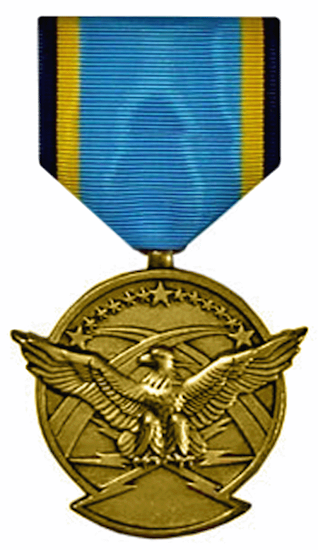
The Aerial Achievement Medal (AAM) is another important distinction of the United States Air Force.
It’s a far more modern award, established in 1988, and intended to recognize achievements that fall just short of the aforementioned Air Medal.
The military award is designed to recognize the contributions of aircrew members who would, otherwise, not earn any type of distinction.
Therefore, the Aerial Achievement Medal can also be awarded to civilian personnel while serving in the capacity of the Air Force.
It has also been presented to operators of unmanned aerial vehicles (UAVs).
Generally, eligible personnel distinguishes themselves by sustained meritorious achievement while participating in aerial flight.
In other words, the achievements must stand out above and beyond what is normally expected of professional airmen.
The primary requirement is that the service member or civilian personnel must complete:
- 20 flights lasting 2 or more hours;
- 1 flight per theater per day.
Nonetheless, certain stipulations allow eligible personnel to earn the military award after just 14 flights.
The Aerial Achievement Medal is approved by local commanders, however, the mission must be approved by a Major Air Force Command (MAJCOMs).
The stylish award features an American bald eagle with its wings extending just beyond the brim of the medal.
Meanwhile, the eagle is seen clutching a cluster of 6 lightning bolts in its talons.
The wings extended are designed to reflect freedom while the 13 pointed stars allude to the original colonies of the United States.
#6. Air & Space Commendation Medal
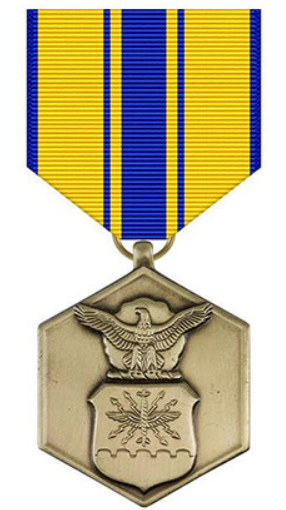
The Air & Space Commendation Medal is a mid-level award shared by both branches of the U.S. Armed Forces.
Moreover, the Commendation Medal is a type of award shared by all branches of the military.
Nonetheless, the United States Air Force was the last service branch to adopt a version of the award in 1958.
Previously, members of the Air Force were eligible for the Army Commendation Medal.
In general, the Commendation Medal is presented for sustained acts of heroism or meritorious service.
Often, qualifying service includes meritorious achievement and service, acts of courage (involving no voluntary risk of life), and sustained meritorious performance of duty.
In the past, approval of the Air & Space Force Commendation Medal is decided by an officer of the rank of Colonel or higher.
Therefore, the award is eligible to both American and foreign military personnel with a rank of O-6 or lower.
Recently, the USAF authorized the “V” device, “C” device, and “R” device to wear along with the medal and service ribbon.
The hexagonal medallion features a shield surmounted by an eagle superimposed over clouds.
Then, the shield features a pair of flyer’s wings along with a vertical baton with an eagle’s claws on each end.
Finally, behind the shield are 7 lighting bolts designed to represent the Department of Air Force Seal.
Multiple award winners proudly display bronze and silver oak leaf clusters on the service ribbon.
#7. Air & Space Achievement Medal
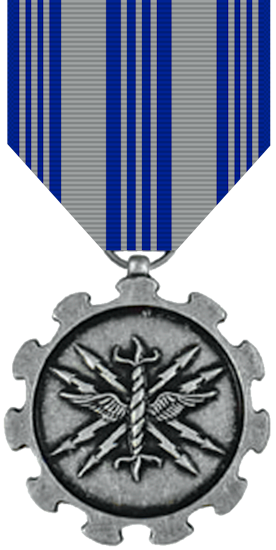
The Achievement Medal is another military award shared by every service branch, including a 5th version offered for joint service by the DoD.
It’s designed to recognize outstanding achievement and meritorious service for conduct that falls just below the Commendation Medal.
In general, award authority is designated to local commanders, who exercise great discretion when deciding who and what deserves the Achievement Medal.
Still, there are certain criteria that military personnel must meet in order to qualify:
- While engaged in military operations against an enemy of the United States;
- While engaged in military operations involving conflict against an opposing foreign force; or
- While serving with friendly foreign forces engaged in military operations with an opposing armed force in which the U.S. it not a belligerent party.
The Air & Space Achievement Medal (AFAM) was established in 1980 to align with the awards of the other branches.
Its design is noteworthy for the outer border composed of 11 cloudlike shapes.
Then, centered on the obverse of the medallion are thunderbolts and wings designed to signify the power of aerospace.
The medal is accompanied by a service ribbon and several devices are authorized to display on the uniform.
These include the “R” device which was created to distinguish an award earned for direct hands-on employment of a weapon system.
Generally, the operation of the weapon system had a direct and immediate impact on a combat operation (i.e. outcome of a military engagement).
These include cyberspace and remotely piloted aircraft operators, along with intelligence and surveillance operations.
#8. Air Force Combat Medal
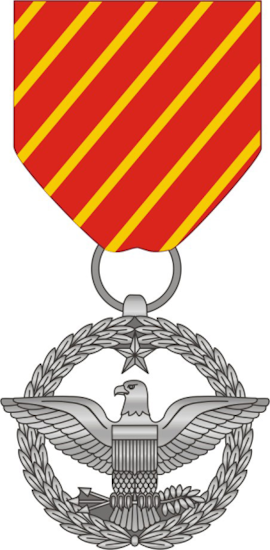
The Air Force Combat Action Medal (CAM) is another important mid-level award.
It’s presented to airmen and guardians for active participation in ground or air combat.
The primary stipulation is that the individual must have been under direct and hostile fire while operating in an unsecured space.
Additionally, the criteria extend to those physically engaging hostile forces with direct and lethal fire.
The Combat Action Medal is one of the most recent additions to military decorations, officially established in 2007.
In fact, the first award recipients were six airmen that were engaged in air and ground combat during Operation Enduring Freedom in Afghanistan.
Furthermore, many recipients have earned the military distinction that was part of Operation Iraqi Freedom.
Moreover, the award is retroactive to September 11, 2001, in order to acknowledge the many acts of heroism that took place thereafter.
It is awarded posthumously just like many other Air Force medals on the list.
The silver design of the Air Force Combat Action Medal is based on the circular insignia found on planes piloted by Brigadier General William “Billy” Mitchell during WWI.
It features a laurel wreath that surrounds an eagle emblem in the middle of the medal.
The shield is designed to represent the power of war since the award is a combat medal.
Meanwhile, the left talon which clutches an olive branch is designed to represent the power of peace.
In the past, the Combat Action Medal has been presented to foreign military members and also now includes members of the U.S. Space Force.
Related Article – Space Force Ranks In Order (Enlisted & Officer)
#9. Air Force Combat Readiness Medal
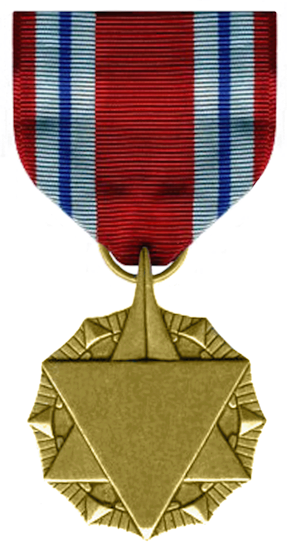
The Combat Readiness Medal is another award specific to the United States Air Force.
Additionally, it has recently extended to include members of the U.S. Space Force.
The original award was established in 1964 yet the criteria for earning it was revised a few years later.
Today, the Air Force Combat Readiness Medal is presented to any member of the USAF who has accomplished sustained individual combat mission readiness of a weapon system.
Moreover, this can include those who have undertaken the preparedness for direct weapon-system employment.
Generally, “combat ready” is defined as being professionally and technically qualified in an aircrew crew position that can be used in combat.
Nonetheless, a service member must complete 24 cumulative months of sustained duty performance in order to be eligible.
It’s not uncommon for those that qualify for the Combat Readiness Medal to also qualify for a higher award, including the Air Medal and Aerial Achievement Medal.
Thus, many Air Force officers and enlisted aircrew personnel are eligible to earn multiple awards simultaneously.
The medal features an inverted triangle on top of wings designed to represent supersonic aircraft.
Furthermore, the design includes triangles at the points intended to reflect the worldwide coverage of the U.S. Air Force.
It’s possible to earn multiple distinctions of the Combat Readiness Medal and are denoted by oak leaf clusters.
#10. Air Force Good Conduct Medal
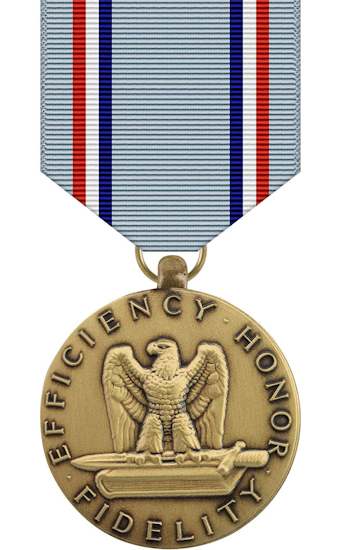
The Good Conduct Medal represents one of the oldest military awards in the U.S. Armed Forces.
Originally, the U.S. Navy was the first service branch to create the award in 1869.
However, the Air Force version of the award didn’t exist until the early 1960s, nearly a century later.
Previously, eligible members of the Air Force received the Army Good Conduct Medal as a substitute from 1947 – 1963.
In fact, the Air Force Good Conduct Medal was temporarily discontinued from 2006 – 2009.
It has since been restored and awarded to airmen that complete 3 years of “good conduct” service.
Generally, this means the service member has not been disciplined for any infractions or court martial offenses.
Be that as it may, those facing disciplinary actions may also be reinstated and eventually qualify for the award (after 3 subsequent years of good service).
More importantly, the criteria are reduced from 3 years to 1 year during times of war.
The appearance of the Air Force Good Conduct Medal has remained unchanged since it was first introduced more than 50 years ago.
In fact, the Air Force version is identical to the appearance of the Army Good Conduct Medal.
It features an American eagle with inverted wings resting on a closed book with a Roman sword.
Then, encircling the medallion are the words “Efficiency, Honor, Fidelity.”
The reverse side can be inscribed with the airmen’s name which is encircled by a wreath of laurel and oak leaves.
Additional awards of the Air Force Good Conduct Medal are distinguished by bronze and silver oak leaf clusters.
Conclusion
The United States Air Force presents military awards, just like the other branches of the Armed Forces.
Accordingly, these medals are displayed on a formal uniform in order of precedence established by the service branch.
Thus, it’s important to recognize the different Air Force awards, including the appearance of the medal and service ribbon.
- Ikon Pass Military Discount: Learn How To Save Big - January 31, 2025
- RTIC Military Discount: Find Out How To Save Big on Gear - January 30, 2025
- Traeger Military Discount: Learn How To Save Big on Smokers - January 28, 2025

